Microfiber Leather Unveiled: Sustainability Meets Luxury

Microfiber leather, a groundbreaking material, has emerged as a frontrunner in the quest for sustainable and ethical alternatives to animal leather. Its unique composition offers an unparalleled blend of durability, practicality, and environmental responsibility. This comprehensive guide uncovers the history, manufacturing process, and myriad advantages of microfiber leather, alongside detailed care instructions to ensure its longevity.
Microfiber leather stands at the intersection of innovation and sustainability, offering a versatile and eco-conscious alternative to traditional leather. Known for its remarkable durability and aesthetic versatility, microfiber leather has gained popularity across various industries, from fashion to automotive.
History and Legacy
The development of microfiber leather can be traced back to the late 20th century, as a response to the growing need for sustainable materials that mimic the properties of natural leather without the ethical and environmental costs. It represents a significant advancement in material science, marrying the principles of sustainability with cutting-edge technology.
How Is Microfiber Leather Is Made?
Microfiber leather is created using a complex process that involves weaving together microscopic fibers, often polyester or nylon, which are then coated with a polyurethane resin to mimic the texture and feel of real leather. This process not only replicates the aesthetic attributes of traditional leather but also enhances functionality and environmental sustainability.
How To Identify Microfiber Leather?
Identifying microfiber leather involves looking for a uniform texture and consistency, along with a soft, pliable feel. Unlike real leather, which can have imperfections and a distinct leather smell, microfiber leather boasts a consistent finish and lacks any natural leather scent.
Characteristics and Qualities
Microfiber leather is celebrated for its exceptional strength, breathability, and water resistance. It maintains its color and texture over time, resisting wear and tear with remarkable efficiency. Additionally, its versatility allows it to be dyed in a wide range of colors, making it an attractive option for designers.
Advantages
- Maintenance: Easy to clean and maintain, requiring only a damp cloth for most spills and stains.
- Eco-Friendly: A sustainable alternative to animal leather, reducing the environmental impact associated with traditional leather production.
- Cost-Effective: Generally more affordable than real leather, providing a budget-friendly option without sacrificing quality or aesthetics.
- Versatility: Suitable for a wide range of applications, from fashion to automotive interiors, thanks to its adaptable nature.
Disadvantages
- Breathability: While more breathable than synthetic leather, it still falls short of the natural breathability of real leather.
- Longevity: Although durable, it may not age as gracefully or acquire the same patina as real leather over time.
- Environmental Concerns: The use of polyurethane in its production raises questions about plastic use, despite its overall lower environmental footprint compared to animal leather.
Care and Maintenance
Maintaining microfiber leather is straightforward, ensuring its longevity and visual appeal: Wipe with a soft, damp cloth. For tougher stains, use a mild soap solution and avoid abrasive cleaners. Do not expose to direct sunlight or heat sources for prolonged periods, as this can cause the material to deteriorate. Use a leather conditioner designed for synthetic leather to maintain its suppleness. Store in a cool, dry place away from direct sunlight to prevent fading and degradation.
Conclusion
While microfiber leather offers numerous advantages in terms of sustainability, affordability, and maintenance, it's essential to acknowledge the unique value and timeless appeal of genuine leather. Real leather boasts unparalleled breathability, durability, and the ability to age gracefully, developing a rich patina that is highly prized among connoisseurs. Its natural texture, scent, and individual characteristics make each piece distinct and imbued with a sense of history and craftsmanship that synthetic alternatives cannot replicate. For those who prioritize these aspects and are willing to invest in care and maintenance, real leather remains the epitome of luxury and environmental consciousness, provided it is sourced responsibly. The choice between microfiber and genuine leather ultimately depends on personal values, preferences, and the specific application, with each material offering its own set of benefits.


